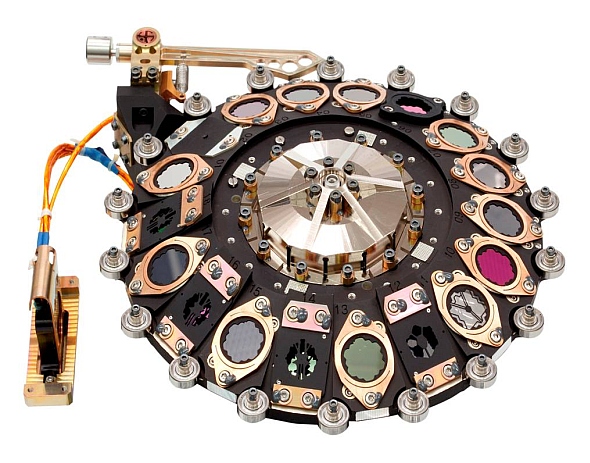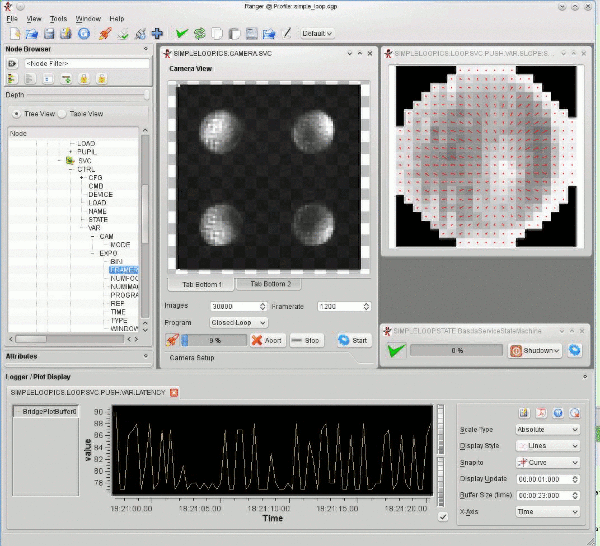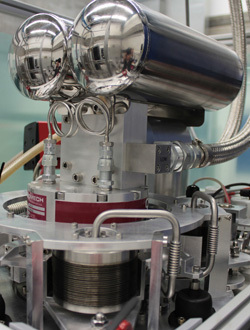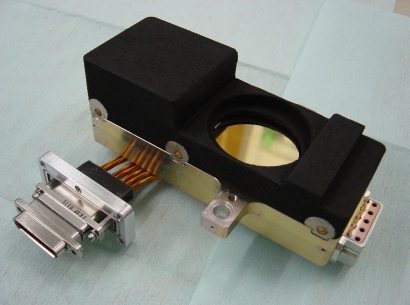| Version 443 (modified by , 4 years ago) (diff) |
|---|
The AstroTechTalk (ger) offers a place to discuss, for all interested colleagues and especially for the technical departments, the project leaders, the administration and the scientists as the ultimately users:
- status of instrumentation projects
- scientific tasks and features of the instruments in construction or planned
- new possible involvements
- technical innovations and developments
- technical problems and their solutions
- logistical problems and their solutions
- how to improve operation and observation
- project standards.
Time: Always Fridays 11:00 - 12:00 (during the construction work: 10:00 - 11:00)
Location: MPIA Hoersaal (during the construction work: HdA Auditorium)
Outline:
- Announcements (news, visitors, etc.) (mainly in German)
- Talk of about 30 min about a selected topic (German or English, will be announced)
- Follow up discussion and questions (German or English, depending on the speaker)
Proposals for talks: Please send an email to "hofferbert -at- mpia.de" or "naranjo -at- mpia.de" - alternatively you might reach us by phone (06221-528209 or -290) or in person (room 211 or 018) at MPIA.
| Date | Speaker | Topic |
| 13.09.2019 | ||
| 20.09.2019 | -- | MPIA 50-year-celebration |
| 27.09.2019 | ||
| 04.10.2019 | -- | Bridge Day after German Unity Day |
| 11.10.2019 (11hrs, MPIA Hoersaal) | Jonathan Crass (University of Notre Dame, USA) | Finding Earth-like planets among the noise - Achieving precision radial velocity measurements with single-mode fibres Today's radial velocity (RV) instruments for planet detection are primarily seeing-limited instruments fed using multi-mode fibres. This design, while previously state-of-the art, leads to systematic errors which is beginning to limit our ability to study some of the most challenging, and consequently most interesting planetary systems. In the era of adaptive optics at large telescope facilities worldwide, it is now possible to inject a diffraction-limited input into single-mode optical fibres to feed next generation RV spectrographs. These have a reduced instrument volume, a stable input source, and can offer improved overall stability and precision for RV over their multi-mode fed counterparts. iLocater is a next-generation precision RV spectrograph under development for the Large Binocular Telescope (LBT). It is one of the first astronomical spectrographs to use single-mode fibres for precision radial velocity measurement and will provide high resolution (R~150,000-240,000) NIR spectra in a stable environment. Jonathan Crass will present an overview of the instrument, its current status and novel science programs. Presentation: English Slides: English Questions: German, English |
| 18.10.2019 | ||
| 25.10.2019 (11hrs, MPIA Hoersaal) | Michael Boehm (ISYS Stuttgart) | Ultralightweight and Adaptive Structures – a Technology for Tomorrow’s Telescopes and Instruments? Lightweight structures have become a reality for many mass-sensitive applications, such as airplane body design, car body design, or large civil engineering structures. For passive structures, these designs present in most cases a minimum in terms of required mass under given safety limitations and user comfort constraints. However, it is possible to stay within these limits and reduce the total embodied mass even further by introducing active structures, which we refer to as ultralightweight design. Through their various actuators, these structures can adapt to external loads and disturbances, thus increasing the utilization of the structure and its elements, which leads to even lighter designs. In light of the expected construction activities within the next 20-30 years, this can help saving millions of tons of concrete and steel and significantly reduce waste production and CO2-emissions of the construction industry. What’s more, the developed methods and ideas can also be applied to any large-scale applications where high masses are critical, such as space flights and airplanes, harbor cranes, ships and even telescopes and their instruments. The talk will focus on ideas, methods and results of our research in the context of adaptive ultralightweight structures with a focus on large civil engineering structures. At the end, possible implications of this technology for telescopes and their instruments will be presented. Presentation: German Slides: English Questions: German, English |
| 01.11.2019 | -- | All Saints |
| 08.11.2019 | ||
| 15.11.2019 | ||
| 22.11.2019 (11Uhr, MPIA Hoersaal) | Prof. Dr. Andreas Heinrich (Aalen University) | Additive Manufacturing of Active and Passive Optical Components The development of additive manufacturing methods has made enormous progress within the last years. Most of the work has been focused in the implementation of mechanical parts, but additive manufacturing technologies also offer great potential in the optics area, allowing new designs with more degrees of freedom and with it completely new approaches. This talk will present and compare the most important methods for additive manufacturing of synthetic materials. Besides, the most characteristic properties of the additive manufactured optics will be presented. Of special importance is the volume scattering and the surface quality. To be able to improve them, corresponding subsequent machining is necessary, which will also be discussed. A very important part of the talk deals with the discussion of various examples of additive manufactured optical parts. On one hand additive manufactured passive optical elements, like optical beam splitters, micro lens arrays, or optics with complex forms will be presented. On the other hand active optical elements, like 3D printed liquid lenses, printed organic light diodes or additive manufactured Random Laser will be discussed. The talk ends with a presentation of the current design of a robot based on an additive manufactured platform being develop currently at the Center for Optical Technologies of the Aalen University. Presentation: German Slides: English Questions: German, English |
| 29.11.2019 (10hrs, HdA Auditorium) | Thomas Ruppel (SwissOptic AG) | Modern fabrication of high-precision-optics - a journey along the optical manufacturing chain In many cases our society's development is driven by the progress in photonic technologies. Take for instance: Steadily shrinking semiconductor structures allow for digital systems of higher performance, modern optical surgery is key for a broad treatment of a population, which is getting older and older, and air or space borne high-performance optical components are vital for environmental surveillance with optical communication at a daily growing data rate. Prerequisites behind all these applications are typically very precise optical components like beam splitters, mirrors, lenses or polarization optics, which have to be produced in high quantity and very high quality. In the context of this talk the requirements for those components and the manufacturing steps will be presented. In some outstanding cases even exotic ideas and technologies are necessary, which will be explained by practical examples. Presentation: German Slides: English Questions: German, English |
| 06.12.2019 (Time TBD, Room TBD) | Zoltan Hubert (University of Grenoble) | MAORY after the redesign Abstract Presentation: German Slides: English Questions: German, English |
| 13.12.2019 | Thomas Henning | Origins of Life |
| 20.12.2019 | Last talk before Christmas Break | |
| 27.12.2019 | -- | Christmas Break |
Preview:
DD.MM.YYYY - Speaker: Title
Postview:
Presentations from 12.09. - 31.12.2014
Presentations from 01.01. - 31.07.2015
Presentations from 01.08. - 31.12.2015
Presentations from 01.01. - 31.07.2016
Presentations from 01.08. - 31.12.2016
Presentations from 01.01. - 31.07.2017
Presentations from 01.08. - 31.12.2017
Presentations from 01.01. - 31.07.2018
Presentations from 01.08. - 31.12.2018
Attachments (11)
- instrum8_gr.jpg (82.6 KB) - added by 10 years ago.
- instrum4_gr.jpg (104.4 KB) - added by 10 years ago.
- pedv3_gr.jpg (213.9 KB) - added by 10 years ago.
- alfa3.5.gif (235.6 KB) - added by 10 years ago.
- CIAO.jpg (3.8 MB) - added by 8 years ago.
- linc_nirvana_labor.jpg (255.2 KB) - added by 8 years ago.
- MATISSE.jpg (43.1 KB) - added by 8 years ago.
- miri_fm_filterwheel.jpg (145.6 KB) - added by 8 years ago.
- PACS-Chopper.jpg (80.0 KB) - added by 8 years ago.
- simple_loop.gif (965.4 KB) - added by 8 years ago.
- teaser.jpg (13.5 KB) - added by 8 years ago.
Download all attachments as: .zip







